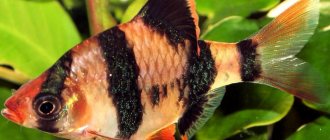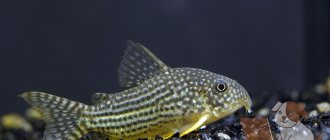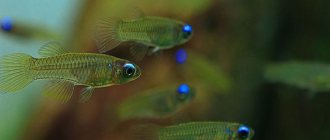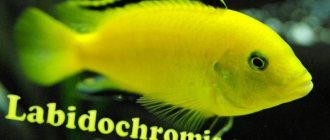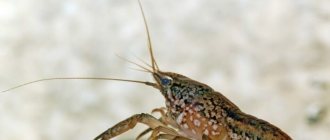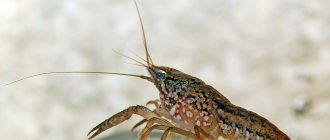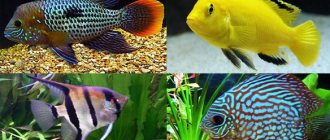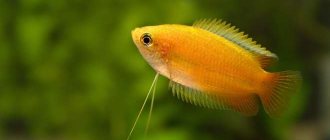Description
Marbled gourami, or cosby, belongs to the ray-finned class, macropod family. These tropical freshwater fish of the Trichogaster genus are classified into 6 separate species. Representatives of this taxonomic unit are also called “threadbearers” due to their long abdominal structures.
The marbled gourami fish is an artificially bred species from the labyrinth family
Origin story
Cosby is a color morph of the Sumatran subspecies, bred by breeders from blue gouramis. On the European continent they learned about these fish in 1934, and in the Soviet Union “Sumatrans” appeared in 1958. The marbled gourami was introduced into the USSR a few years later in 1960 under the incorrect name - crosbi. This error caused several variations in the identification of the marbled gourami - “Cosby”, “Crosby”.
The word "gourami" in the Austronesian language applies to all fish that stick their snout out of the water.
Appearance
Marbled gourami grow up to 8-13 cm in length; there are also dwarf gourami, their sizes are smaller. Their body is leaf-shaped and covered with ctenoid scales.
The size of the marbled subspecies is 8–13 cm
Description of the species:
- The body is tall, flat and oblong.
- The head is medium-sized with a short snout, a terminal mouth and large eyes.
- On the lower abdominal part there is a pair of thread-like antennae, commensurate with the length of the body.
- The dorsal fin is high; the anal is wide and long, extending from the anus, which is located almost at the level of the gill covers, to the caudal peduncle, forked by a notch.
The Cosby's color is silver-blue, with a chaotic pattern of dark linear streaks of irregular shape. The fins are dark gray with light, frequent spots of varying sizes.
This combination of merging or separate pigmented areas resembles a marble texture, which is why the morph was named.
Character
The aquarium fish gourami is non-conflicting, with a balanced, peaceful character. When a school is kept in a small aquarium, males show intraspecific aggression in the fight for females.
Gourami's character is calm and peaceful, so they get along with many fish.
Appearance
Externally, the fish resembles a leaf with its body flattened on the sides and large fins. The color of this gourami is attractive: dark spots are scattered across the blue background, just like on polished marble.
On the abdomen there are two modified fins, similar to long antennae, which are equipped with very sensitive cells. This transformation allows the fish to explore the surrounding space by feeling the objects around it.
In addition to the antennae, the marbled gourami has four more fins: dorsal, anal, caudal and pectoral. The dorsal one is very short in shape, the anal one stretches from the anus to the base of the tail, and the remaining two have a transparent structure.
Physiological features
The difficult conditions of the natural environment in which wild speciation-forming individuals live were also reflected in the physiological characteristics of the selected Cosby morph. Natural forms of gouramis live in ecosystems with low oxygen levels and poor visibility. To survive in such conditions, the evolutionary process endowed fish with a labyrinthine apparatus and an additional type of receptor.
Thanks to the epibranchial organ, gourami can breathe atmospheric air. This anatomical feature compensates the fish for the lack of oxygen dissolved in water. The labyrinth is located in the expansion of the first gill arch. This cavity is formed by thin plates that are covered with a vascular mucous membrane.
Marbled gouramis are labyrinthine, so they can breathe not only through their gills.
Additional tactile organs are represented in gourami by a pair of processes formed by the first rays of the pectoral fins. With their help, a threader in troubled water:
- feels the bottom;
- looking for food;
- senses the approach of a predator.
The tissues of the filamentous processes are capable of regeneration and, when broken off, grow back over time.
When unfavorable conditions develop, gouramiids are able to remain without water for up to 6-8 hours.
Lifespan
Marbled gouramis live 7–8 years in an aquarium. In wild representatives of the genus in the natural environment, this period is almost half as long.
The lifespan of these beautiful fish is 7-8 years
Character
Even aquarium fish have their own character. The marbled gourami is distinguished by its peace-loving nature and tolerance of its neighbors, which allows you to place it with other fish that have the same qualities with a calm heart.
Sometimes males can start fights among themselves, but they are short-lived and do not lead to serious consequences.
Along with other labyrinth fish, marbled gouramis are able to breathe atmospheric oxygen, and this contributes to their survival even in unfavorable conditions.
Habitat
Blue gouramis (cosby species) inhabit Southeast Asia. They live in the flooded lowlands of the island of Sumatra:
- swamps;
- ditches;
- streams;
- pits;
- irrigation canals;
- rice fields.
Tropical threadworms prefer natural, stagnant bodies of water with abundant vegetation and feed on bioplankton and insects. They occupy the middle and surface layers in order to have time to capture atmospheric air, thus compensating for the lack of oxygen.
Gouramis live in rivers, streams, ditches and lakes in Southeast Asia
Thread-bearing gourami are able to hunt insects flying near the surface of a reservoir. They knock down small midges with a stream of water from their mouths and then pick up the fallen prey.
Maintenance and care
Marbled gouramis are unpretentious aquarium fish, since genetically they have inherited a sufficient reserve of endurance from their ancestors. To keep them you need a small herbalist or a multi-species aquarium with shelters. Like all threadfish, cosby fish are undemanding when it comes to food and water composition.
Aquarium
Marbled Cosbys are kept in a 30-40 liter frame or frameless aquarium. For a couple of fish, 15 liters of water is enough. Spacious structures promote fish growth and swimming activity, and reduce territorial aggression in males.
To keep gourami you need a spacious aquarium
The aquarium is equipped with a light lid, which will level the temperature of the gaseous and aqueous environment. This way the fish will swallow warm, non-cold atmospheric air under the lid.
Water parameters
The aquarium is not completely filled with settled water, leaving about 8 cm to the edge. Marbled gouramis are undemanding to the composition of the environment, but are sensitive to its temperature, as they are heat-loving fish.
| Optimal physical and chemical water parameters for keeping marbled gourami | |
| Acidity | 6.5–7.5 pH |
| Rigidity | 6-20 Gh |
| Temperature | 22–28 °C |
Thread carriers love the “old” environment in which the nitrogen cycle has taken place. Fresh, settled water increases aggression in males.
Filter and aeration
Since marbled gouramis have a well-developed labyrinth organ, they do not need a compressor to saturate the water with oxygen. It is advisable to equip the aquarium with filter elements to reduce the level of organic pollutants in the habitat. It is important to take into account that Cosby does not like undercurrents. It is better to choose low-power filter models and direct the flow of water into a dead space.
It is recommended to equip an aquarium for gourami with filters that do not create significant water flows
The labyrinthine organ in fry develops only by the third week, and unlike adults, the brood needs aeration of the water.
Vegetation
Cosby loves dense vegetation. It is planted around the perimeter of the aquarium, alternating with decorative elements, leaving the foreground free for swimming. Any aquaculture is suitable for marbled gourami; they thrive in thickets:
- hornwort;
- pinnate;
- cryptocorynes;
- Elodea;
- coin boxes.
Plants placed on the surface shade bright light and imitate the natural environment.
Hornwort
Cirrus
Cryptocoryne
Elodea
Coin Thickets
Pistia
Duckweed in an aquarium
Salvinia
Waterfowl aquacultures are suitable for these purposes:
- pistia;
- duckweed;
- salvinia.
The herbalist must be periodically thinned out - trimmed, rotten leaves and shoots removed. And for plants floating on the surface, it is recommended to use restrictive contours so that the labyrinth fish always has access to atmospheric air.
Priming
For marbled gourami, the soil can be made from any type of substrate.
It is important that it is dark in color and suitable for the aquacultures growing in the ecosystem. Suitable for planting:
- pebbles;
- coarse sand;
- granite chips.
Pebbles
Coarse sand
Granite chips
Decorative installations can be made of ceramic, polymer, or wooden materials.
Lighting
Gourami fish do not particularly need lighting; it is needed more for the life of plants. To do this, install bright lamp equipment in the aquarium and shade it. Some lighting elements also serve as an additional source of heat, which tropical threaders love so much.
Equipment
During the cold season or in well-conditioned rooms, an aquarium with gourami needs an additional heat source. To do this, the tank is equipped with a heater with a thermostat.
It is recommended to install a heater in the aquarium, which will automatically heat the water to the desired temperature
Feeding
Marbled gourami are omnivores and can tolerate the absence of food brought into the aquarium for several weeks.
In such conditions, they satisfy their hunger with parasites that live in the environment - hydras, planaria or algae. But you shouldn’t test the endurance of the thread-bearers. For fish to be healthy and beautiful, their diet must be balanced, enriched with plant components and bioactive additives. The best protein food for Cosby is live or frozen:
- bloodworm;
- tubifex;
- Cyclops;
- microworm.
For variety, the menu includes a dry branded diet and food made from daphnia.
Bloodworm
Tubifex food
Feed Cyclops
Microworms
Daphnia
Carotenoids are natural organic pigments that some manufacturers include in granules or flakes to enhance the color of aquarium fish.
Compatibility
Cosbys are most aggressive towards members of their own species, especially if the number of males in the aquarium predominates or there are no formed pairs.
Marbled gouramis can also be kept with other peace-loving species of small and medium sizes:
- viviparous;
- small cichlids;
- carp;
- characins.
Compatibility chart of gouramis with other aquarium inhabitants
Peaceful coexistence is achieved when the fish grow in the same aquarium. In this case, adults raised together will have the least degree of aggression and can peacefully share the territory. At the same time, specimens placed even for a short period of time, when returned to the general aquarium, will no longer be accepted by the flock and will begin to openly conflict.
| Keeping marbled gourami in a multi-species aquarium | ||
| Compatible | Limited | Incompatible |
| Angelfish | Gourami | Macropods |
| Mollies | Barbs | Cockerels |
| Rasbory | Swordtails | Pineapples |
| Danio | Guppy | South African cichlids |
| Pecilia | Discus | African cichlids |
| Labeo | Acne | Astronotuses |
| Tetras | Koi | |
| Neons | Parrots | |
| Rainbows | Goldfish | |
| Corridors | ||
| Plecostomus | ||
Not only fights can cause limitations in compatibility. Keeping, for example, marbled gourami with swordtails and barbs usually ends with biting off the antennae or fins.
Sections of the site
- Aquarium fish
- Aquarium fish: for beginners
- Aquarium fish: viviparous
- Aquarium fish: golden
- Aquarium fish: other
- Aquarium fish: carp
- Aquarium fish: large
- Aquarium fish: labyrinthine
- Aquarium fish: unusual
- Aquarium fish: iris
- Aquarium fish: catfish
- Aquarium fish: characins
- Aquarium fish: cichlids
- Amphibians
- Cats
- Crustaceans
- Reptiles
- Dogs
- Dogs: Bichons
- Dogs: Fighting
- Dogs: Greyhounds
- Dogs: Hounds
- Dogs: for children and companions
- Dogs: Indoor and decorative
- Dogs: large breeds
- Dogs: Pointers
- Dogs: small breeds
- Dogs: Molossians and Mastiffs
- Dogs: Shepherds
- Dogs: hunting
- Dogs: Herding
- Dogs: Pinschers
- Dogs: Spaniels
- Dogs: medium breeds
- Dogs: Terriers
- Snails
- Aquarium care
- Spitz
- pearl;
- spotted;
- blue;
- marble.
Reproduction
Marbled gouramis are spawn-laying fish. They reproduce easily and do not require hormonal stimulation. You need to start breeding Cosby by setting up a spawning ground with a large water surface. For these purposes, you need a spacious structure with a volume of about 50 liters. The reservoir is filled with water at a level of 15 cm and a lot of vegetation is placed in it.
It is advisable that the spawning aquarium have a volume of at least 50 liters
In order for the fish to reproduce well, they begin to be intensively fed with live protein food and imitate the onset of spring, increasing the temperature of the environment.
| Optimal physical and chemical water parameters for breeding marbled gouramis | |
| Acidity | 6.5–7.5 pH |
| Rigidity | 10 Gh |
| Temperature | 25–30 °C |
No soil is needed in the spawning tank. Plants can be placed on the bottom directly in pots or placed in the water column in aquaculture that does not require rooting.
Sex differences
Aquarium marbled gourami fish (male and female) are capable of reproduction from 6-8 months. Before this age, it will be difficult to determine gender due to the lack of physiological differences.
| Size | Large | Small |
| Body Shape | Flat | Round |
| Edge of the dorsal fin | Spicy | Rounded |
| Anal fin edge | Spicy | Rounded |
When the male is excited, slight metamorphoses occur in his appearance - the color becomes brighter, and the dark spots appear more pronounced. This period lasts throughout spawning or if a competing male appears in the flock.
Spawning
A couple of breeders are transplanted into a spawning tank. The male begins to build a nest from air bubbles and salivary fluid near the water surface. He mainly makes such areas in the corners of the aquarium.
A male gourami builds a nest from air bubbles, pieces of plants and saliva
At this moment, the female's eggs ripen in her belly. She is almost always found in aquaculture thickets, since the male constantly pursues her, displaying aggressive behavior.
When the nest is built, the pair begins mating games. The female stops hiding, comes out of hiding and swims up to the nest. The male circles around the female, helping her release the eggs, which he immediately fertilizes. Spawning resembles a kind of “dance” that occurs with short pauses.
The spawning process of marbled gourami is like a dance
After the end of spawning, the male is responsible for placing the eggs in the nest. At this time, he becomes especially aggressive, so the female must be removed immediately after mating. She does not take care of the brood, but will be subjected to harsh actions by the male, who during this period may even kill her.
Raising fry
The male protects the future offspring and takes care of the eggs - adding new air bubbles, returning the melted eggs to the nest.
The larvae hatch after 24-30 hours and remain immobilized for two to three days. On the 3-4th day, the brood is already able to swim and feed. At this stage, the male loses his parental instinct and is removed from the spawning area. The larvae are fed:
- ciliates;
- living dust;
- mashed egg yolk dissolved in water.
Living dust
Ciliate slipper
Pounded egg yolk
As they grow older, the following is introduced into the diet:
- microworms;
- nauplii;
- brine shrimp.
At the 3-4th week, the spawning tank is provided with weak aeration and the water level is lowered to 10 cm, until the fry have formed a labyrinthine organ. Water changes are carried out once a week.
How to distinguish a male from a female
It is quite easy to distinguish a boy from a girl gourami: there are several characteristic features.
| Male | Female |
| Larger | Smaller body |
| Slimmer look | Round shape |
| Bright color | Somewhat muted colors |
| The dorsal fin is large and elongated | Dorsal fin small, rounded |
| Pectoral fins orange | Pectoral fins yellow |
| During arousal, the breast changes color and becomes brighter | No changes observed |
Diseases and prevention
Marbled gouramis have good immunity and, under favorable conditions, rarely get sick.
With insufficient care and neglect of quarantine measures, even the most persistent species of aquarium fish will be susceptible to pathological conditions.
Infections to which the marbled gourami is prone include:
- lymphocystosis;
- pseudomonosis;
- aeromonosis
Weakened individuals are more likely to get sick. To ensure that the level of immune protection does not decrease, it is necessary to maintain a comfortable temperature of the water in the aquarium, avoid sudden changes in temperature and feed the Cosby moderately, adhering to a balanced diet.
Proper care and appropriate water parameters are the key to the health and longevity of aquarium fish
Excess food, as well as too little, can negatively affect the health of fish.
To prevent invasive and infectious diseases, it is recommended to wash live food well and deep freeze it. This will reduce the likelihood of introducing pathogens and parasites into the aquarium.
Coloring is one of the main indicators of the condition of the fish. The bright color of the integument is an indicator of good health.
Lymphocystosis
Chronic viral disease caused by Lymphocystivirus. Small and medium-sized warts and irregularly shaped nodules appear on the integument of infected individuals. On lightly colored fabrics, such formations are often gray or cream in color. Pigmented areas of the body may take on a different shade. The growth forms within 24 hours and remains on the integument for about a week.
Symptoms of lymphocystosis in gourami
Infection occurs through contact with an infected animal. Traumatic factors aggravate the process.
Most often, lymphocystosis goes away without treatment in 3-6 weeks, since there is no effective therapy for this disease. In this case, it is necessary to ensure that the water in the aquarium fully complies with the physical and chemical parameters, and that the food is of high quality and enriched with a vitamin-mineral complex. In valuable individuals, nodular formations are sometimes cauterized with electric current.
Pseudomonosis
A bacterial disease, second name - white-skinned, the causative agent is a virulent strain of Pseudomonas. It manifests itself as bulging eyes, a swollen belly and ruffled scales. In areas where the cover is lifted, the tissues become white. Crescent hemorrhages occur in the area of the fins and gills. Gray small ulcerations with irregular red edges form, which can merge to form craters.
Characteristic symptoms of pseudomonosis are reddish ulcers
A sick fish loses its balance and swims head down.
Pseudomonosis is treated:
- minocycline – 70 mg/l 30 min.;
- biomycin – 25 mg/l, 5 days;
- zinc or copper sulfate – 16 g/l from a solution of 1 cm3 per 10 l.
Branded drugs for pseudomonosis - Ichthyovit Antibak, API Furan-2, Fiosept, Sera bakto Tabs, Nala-Gram, TetraMedica GoldOomed, etc.
Aeromonosis
Bacterial disease, otherwise - rubella or abdominal dropsy, Aeromonas pathogen and other pathogens. Characteristic signs of the pathology are the formation of red areas on the integument (the abdominal area is more often affected), ruffling of scales, bulging eyes, and a bloated belly.
Aeromonosis affects individuals with weakened immune systems
The fish becomes apathetic and loses its appetite.
Treatment of aeromonosis:
- sulfanilamide – 100-250 mg/l;
- neomycin, biomycin, ericycline, kanamycin – 25-50 mg/l, 5-10 days;
- bicillin-5 - 500,000 units per 100 l, in a general aquarium for 6-7 days.
Rubella medications – Antibak, API Furan-2, Sera bakto Tabs, Nala-Gram, Sera baktopur direct, etc.
Aeromonosis can be treated only in the initial stages. If dropsy develops and the scales begin to fall out, treatment will no longer be effective.
Nutrition
The fry will grow best if you feed ciliates and nauplii of crustaceans. Some aquarists practice feeding boiled egg yolk, but this may not give good results.
Many fish don’t mind eating a regular cucumber.
Adult fish are not picky eaters; moreover, they are not afraid of parasites such as hydra or planaria. Preferable, of course, is live food: bloodworms and tubifex. With appetite, marbled gouramis eat raw meat, if it is finely scraped, as well as finely chopped lettuce or dandelion leaves.
Dry and frozen food can be used, but not as the basis of the diet.
Quarantine
Quarantine measures reduce the risk of infection in the aquarium. This allows the disease to be diagnosed and monitored in isolated fish.
If there are unusual changes in appearance or behavior, the fish should be transferred to another tank.
For quarantine, a separate 15-20 liter tank is used, where a new or presumably unhealthy individual will be kept under observation for two weeks or more.
The following preventive antiseptics are introduced into the quarantine area every day for 10-20 minutes:
- 2% saline solutions - 2 tsp per 1 liter of water. table salt;
- malachite green – 6 mg per 10 liters of water;
- a weak solution of potassium permanganate or brilliant green - a volume is added to slightly tint the water;
- methylene blue – 25 ml per 10 l;
- bicillin-5 – 50,000 BD per 10 liters of water.
2% saline solution
Malachite green preparation
Weak solution of potassium permanganate
Methylene blue drug
The drug Bicillin-5
After antiseptic procedures, the solution is poured out and the fish is kept in fresh, clean water.
After the quarantine period has expired and if there are no signs of disease, the isolated individual is transferred to a common aquarium.
Social behavior
Adults exhibit individual behavioral traits ranging from shyness to aggression, which can create problems in the future, especially if a very temperamental fish is encountered. However, hostility is directed primarily towards newcomers, and to a lesser extent towards those with whom Gourami grew up. There is a clear intraspecific hierarchy, the stronger male becomes the dominant individual and can attack his weak relatives. Single, pair or harem housing seems optimal. You can choose from large and calm fish as neighbors, such as some catfish. Active individuals provoke aggression, and very small fish can be perceived as food/prey.
Price
Marbled gourami are widely available for sale and are sold at different prices in markets, pet stores, on websites where private advertisements are posted, and online trading platforms. Most often, the cost is determined by the size of the individual.
Average price of marble gourami in the online store:
- 3 cm – 95 RUR;
- 5 cm – 130 rub.;
- 6.5 cm – 210 rub.;
- 8 cm – 310 rub.
You can purchase thread carriers from private breeders at a lower cost - from 25-30 rubles.
Color
The color of the gourami is also important. In fish, males are often more variegated and brighter in color than females.
Before spawning, the most expressive distinctive signs appear:
- males acquire a brighter color than females;
- The belly of males becomes golden-orange or bright red.
The exception is the Veilanta gourami. During spawning, females of this species are brighter in color than males. In other varieties, females have a darker belly, but the overall color does not change.
Despite the cold coloration of pearl and marbled gouramis, during spawning the males of these species are decorated with a red stripe on the belly. In gouramis that have a warm color, for example, honey gourami, in addition to the bright stripe, a dark-colored spot may appear.
Adviсe
If Cosbys live in an aquarium, then it is important to take into account the characteristics characteristic of the species. This approach will have the most favorable effect on their condition and will reduce the likelihood of stress and illness in fish.
Tips for keeping and breeding marbled gourami:
- If it is not possible to feed gourami a variety of foods, preference should be given to freeze-dried food. Such diets are distinguished by their multicomponent composition and high nutritional value.
- A strong current in an aquarium and trying to cope with it leads to unnecessary physical exertion and can cause stress in the fish. To minimize the movement of water in the tank, the filter is equipped with special nozzles that control the strength of the flow.
- If in a flock there are several females per male, his level of aggression will be lower.
- A large number of hiding places will reduce the number of skirmishes and fights in a multi-species aquarium.
- A portion of fresh, settled water added to the spawning tank is a good stimulant for mating.
- It is better to give bloodworms to fish before spawning. Prey such as daphnia and cyclops predispose breeders to eat their offspring due to the crustaceans' resemblance to larvae. Gourami can mistake their brood for food.
- The fry grows unevenly, so it must be regularly sorted so that strong individuals do not exterminate their weaker counterparts.
Grottoes in the aquarium will protect the fish from aggressive neighbors
Even if there is a sufficient amount of dissolved oxygen in the water, without access to atmospheric air the gourami will die.
What to feed marbled gourami?
Marbled gouramis, like all their other species, are unpretentious in nutrition - they are ready to absorb absolutely any food, even midges and other insects flying over the aquarium. It is important to adhere to the main requirement - the diet should be varied, since without this, fish grow and reproduce poorly.
What food to give:
- insect larvae;
- frozen food - brine shrimp, tubifex, bloodworms, etc.;
- planaria, hydra;
- chopped dietary meat;
- leaves from dandelion, wood lice, lettuce;
- ready-made food - plates, flakes, granules, etc.
The feeding regime is not strict - it is enough to give food once a day and even every other day. If the aquarist leaves for 1-2 weeks, the fish will not die, because they are able to live this time without food.
There are a number of universal feeds, for example:
- TetraPro Energy. Intended for tropical animals, which include the marbled gourami. It comes in the form of chips that need to be crushed. In addition to nutrients, it contains energy concentrates to increase activity.
- TetraMin. It is a universal and balanced food in the form of flakes containing all the necessary beneficial elements.
- TetraPhyll Granules. It is produced in the form of granules that sink slowly. The basis is plant food.
There are other foods that are selected individually - depending on the needs of the fish, the financial capabilities of the aquarist, and ease of use.
Reviews
Marbled gourami can be recommended to those who are planning to buy an aquarium and have never had experience in keeping fish before. It can withstand the disadvantages of its environment and will forgive a beginner short-term errors in care. The measured and unhurried behavior of gourami in the aquarium allows you to temporarily escape from the daily hustle and bustle and relax, being alone with wildlife.Have you ever kept these fish? Share your impressions about them in the comments.
Compatibility
The compatibility of gourami with other fish is quite high. The marbled gourami gets along well in a common aquarium with peaceful and calm species: angelfish (angelfish), barb fish, rasboras, swordtails, tetras and mollies. Catfish are good neighbors.
Don't get along very well together:
- different types of gourami (for example, marbled gourami with opaline);
- with aggressive discus and eels;
- with guppy;
- with shrimps and crabs.
They don't get along:
- with territorial species - goldfish, parrotfish, cichlids;
- with cockerels;
- with koi carp;
- astronotuses.



